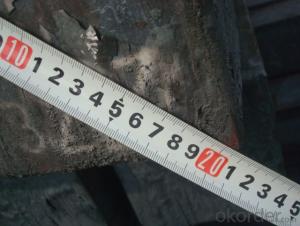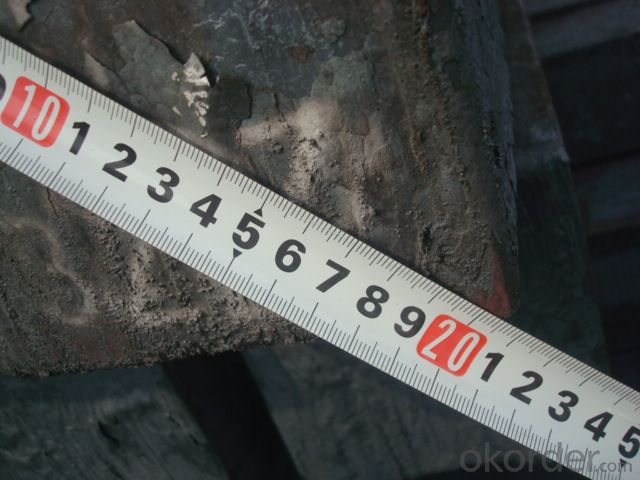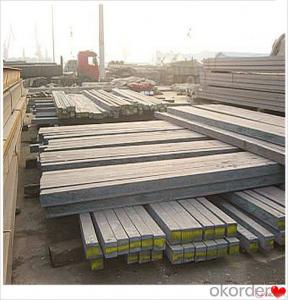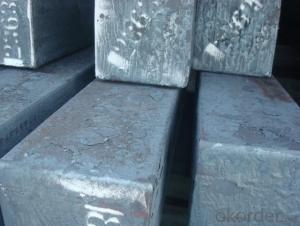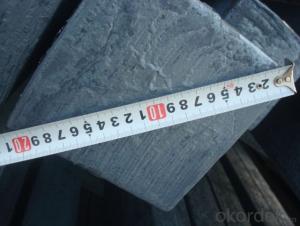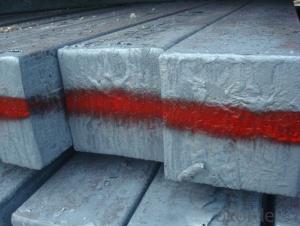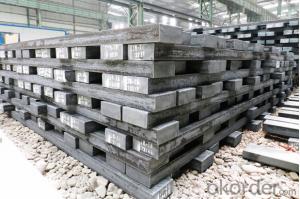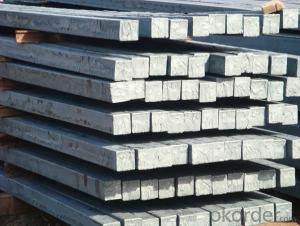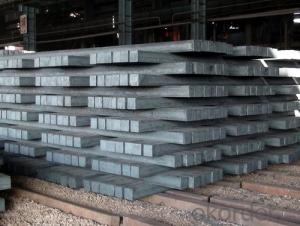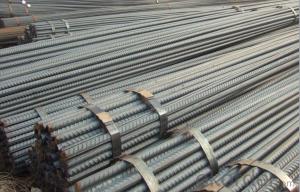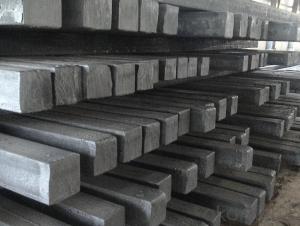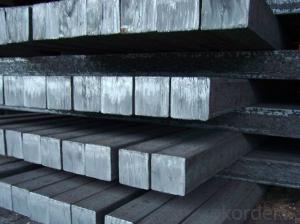Continuous Casting Steel Billet Q235 in Amazing Price
- Loading Port:
- Tianjin
- Payment Terms:
- TT OR LC
- Min Order Qty:
- 1000 m.t.
- Supply Capability:
- 200000 m.t./month
OKorder Service Pledge
OKorder Financial Service
You Might Also Like
STEEL BILLET
1.Structure of Steel Billet
Steel billet(ingot) by cogging or breakdown of semi-finished products, is the raw material of all kinds of steel mill. Billet section of square, round, flat, rectangular and abnormity of several kinds of, mainly related to the shape of rolled products.
2.Main Features of Steel Billet
Rectangular billet continuous casting billet and mainly general carbon steel, low carbon low silicon cold-rolled material, high quality carbon structural steel, high strength low alloy steel, special steel, etc.
The billet is mainly divided into two kinds from the shape:
Slab: cross section width and height of the ratio of the larger, mainly used for rolling plate.
Billet: equal cross section width and height, or a huge difference, mainly used for rolling steel, wire rod. ,
Steel billets have distinct characteristics as compared with already furnished steel bars and products. Billets have a specific grain structure, which enables the metal to be processed more intricately. Steel billets are also known for their malleability and ductility, especially when exposed to varying temperatures during shaping and molding.
3.Processing of Steel Billet
Steel billets are considered fresh and raw, and they must undergo a series of manufacturing processes before they can be used for various purposes. Billets are made by means of freezing molten liquid, and are later exposed to extremely low temperatures in order to allow the metal to take shape and solidify in chemical structure. The temperature manipulates the metal's physical properties, and tones its strength and durability. The subsequent processes provide the metal's curved mold design so that it can fit the allotted space provided by other machines, which complete the finishing procedures.
4.Steel Billet Images
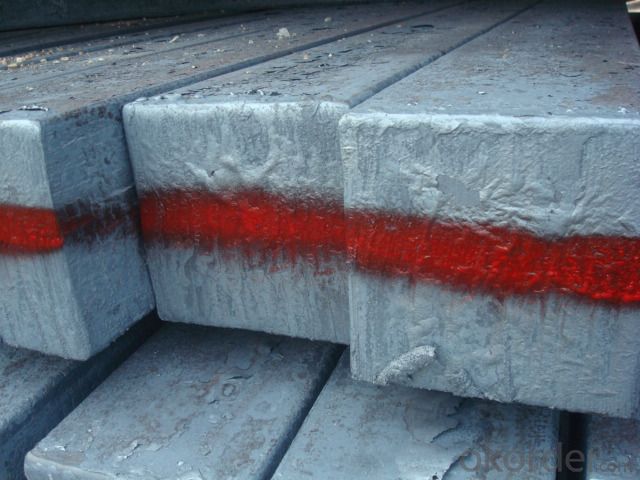
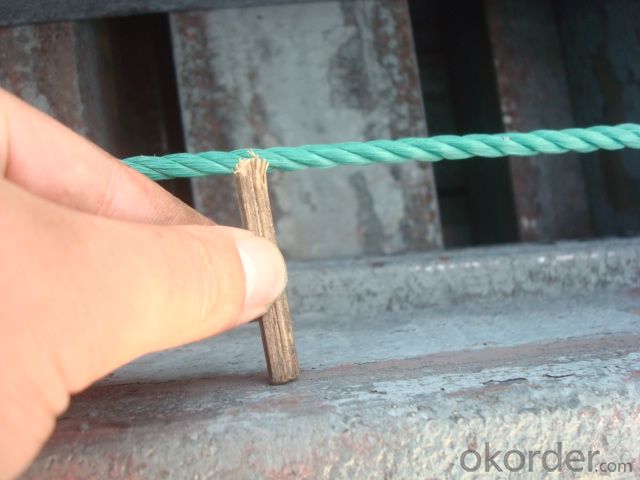
5.Usage of Steel Billet
Billets, or ingots (as they sometimes referred to), are not of practical use until they have been formed into more functional shapes and sizes. While they have already been put in the furnace, they still require a series of shaping and molding procedures such as hot and cold working, milling and cutting before they are sold in hardware stores, or used for different applications. The unformed billets, however, can be used in striking currency such as coins and as reserves, similar to gold bars.
6. Steel Billet Specification
Hot rolled billet steel
Size: 50x50mm-180x180mm
Steel Grade: 3SP, 5SP,Q195,Q235,Q255,Q275 Length:3m-12m
MOQ: 1000MT/size
Payment term: TT or LC
Packing: in bulk , bundle
Shipment: by container , bulk vessel
Packaging Details: bundles with steel strips or as customers's requirements
Delivery time: 15-30 days after the deposit
Loading port:Tianjin, or other port China
Origin :China
Inspection:Third party inspection before loading.
7.FAQ
We have organized several common questions for our clients,may help you sincerely:
1) How about your company?
A world class manufacturer & supplier of castings forging in carbon steel and alloy steel,is one of the large-scale professional investment casting production bases in China,consisting of both casting foundry forging and machining factory. Annually more than 8000 tons Precision casting and forging parts are exported to markets in Europe,America and Japan. OEM casting and forging service available according to customer’s requirements.
2) How to guarantee the quality of the products?
We have established the international advanced quality management system,every link from raw material to final product we have strict quality test;We resolutely put an end to unqualified products flowing into the market. At the same time, we will provide necessary follow-up service assurance.
3) How long can we receive the product after purchase?
In the purchase of product within three working days, We will arrange the factory delivery as soon as possible. The pecific time of receiving is related to the state and position of customers.Commonly 7 to 10 working days can be served.
4)Do you have your own QC department?
Yes, we have, our QC department will inspect the goods during the process of mass production and after completion of production.
- Q: How do steel billets contribute to the manufacturing of automotive parts?
- Steel billets play a crucial role in the manufacturing of automotive parts by serving as the primary raw material for the production of various components. Automotive manufacturers rely on steel billets due to their excellent strength, durability, and malleability properties. Firstly, steel billets are used to produce engine parts such as crankshafts, connecting rods, and camshafts. These components require high strength and precision, which can be achieved by using steel billets as the starting material. The billets are heated, forged, and machined to shape them into the desired form, ensuring the necessary strength and accuracy for optimal engine performance. Additionally, steel billets are utilized in the production of suspension and chassis components. These parts, including control arms, axles, and frame sections, require exceptional toughness and resistance to withstand the constant stresses and strains experienced by the vehicle. Steel billets provide the necessary mechanical properties to ensure the safety and longevity of these crucial automotive components. Furthermore, steel billets are also used in the manufacturing of various transmission and drivetrain parts. Gears, shafts, and differential components require excellent wear resistance, strength, and dimensional accuracy to ensure the efficiency and reliability of the vehicle's power transmission system. Steel billets are forged and machined to produce these parts, meeting the strict requirements of the automotive industry. Moreover, steel billets contribute to the production of body and exterior components such as doors, hoods, fenders, and frames. These parts require high strength, corrosion resistance, and the ability to be formed into complex shapes. Steel billets can be hot or cold rolled, pressed, stamped, or welded to manufacture these components, providing the necessary structural integrity and aesthetics for automotive bodies. Overall, steel billets are essential in the manufacturing of automotive parts due to their superior mechanical properties and versatility. They enable the production of high-quality, durable, and reliable components that meet the demanding requirements of the automotive industry. The use of steel billets ensures the safety, performance, and longevity of vehicles, contributing to the overall quality of the automotive manufacturing process.
- Q: What are the main factors affecting the metallurgical properties of steel billets?
- The metallurgical properties of steel billets are influenced by several key factors. These factors encompass the steel's composition, the applied heat treatment, the presence of impurities, and the rate at which it cools. The composition of the steel plays a pivotal role in determining its metallurgical properties. The steel's strength, hardness, and ductility are significantly impacted by the amount of carbon present, as well as the inclusion of other alloying elements like manganese, chromium, and nickel. Additionally, different compositions can affect the steel's ability to resist corrosion or exhibit magnetic properties. Heat treatment is another crucial factor that affects the metallurgical properties of steel billets. Through this process, the steel is heated to a specific temperature and then cooled at a controlled rate. By altering the steel's microstructure, heat treatment influences its hardness, toughness, and overall mechanical properties. Various methods of heat treatment, such as annealing, quenching, and tempering, can be employed to achieve desired metallurgical properties. The presence of impurities in the steel also has an impact on its metallurgical properties. Impurities like sulfur, phosphorus, and oxygen can have negative effects on the steel's mechanical properties, diminishing its strength and ductility. Hence, minimizing the level of impurities is crucial to ensure the desired metallurgical properties. Lastly, the cooling rate during the solidification process plays a pivotal role in determining the steel billets' microstructure and properties. Rapid cooling, as seen in quenching, leads to a fine-grained microstructure that enhances the steel's strength and hardness. Conversely, slow cooling, such as during annealing, results in a coarse-grained microstructure that improves the steel's ductility and toughness. In conclusion, the metallurgical properties of steel billets are influenced by factors such as composition, heat treatment, impurities, and cooling rate. These factors are interconnected and must be carefully controlled to achieve the desired properties for various applications.
- Q: How are steel billets used in the manufacturing of oil and gas components?
- Steel billets are an essential material used in the manufacturing of oil and gas components. These billets are semi-finished products that are typically made through a process called casting, where molten steel is poured into a mold and allowed to solidify into a rectangular shape. Once the steel billets are formed, they are used in various ways to produce components for the oil and gas industry. One common application is in the production of pipes, which are crucial for transporting oil and gas from the reservoirs to the processing facilities or end-users. Steel billets can be further processed to create seamless or welded pipes, depending on the specific requirements of the project. In addition to pipes, steel billets are also used to manufacture other oil and gas components such as valves, fittings, flanges, and pressure vessels. These components are vital for the safe and efficient operation of oil and gas facilities, as they ensure proper flow control, connection, and containment of fluids under high pressures and temperatures. The use of steel billets in the manufacturing of oil and gas components offers several advantages. Firstly, steel is known for its strength, durability, and resistance to corrosion, making it well-suited for the harsh and demanding operating conditions of the oil and gas industry. Additionally, steel billets allow for flexibility in terms of size, shape, and composition, which enables manufacturers to produce components that meet specific project requirements. Overall, steel billets play a critical role in the production of oil and gas components, providing the necessary strength, durability, and versatility required for the safe and efficient operation of the industry.
- Q: What is the role of steel billets in the construction of power plants?
- The construction of power plants relies heavily on steel billets, which are semi-finished steel products utilized as raw materials in various processes involved in power plant production. A significant application of steel billets in this field is the creation of structural steel, which forms the framework of power plant structures like the main building, turbine halls, reactor buildings, and cooling towers. To produce the necessary structural components such as beams, columns, and trusses, steel billets are melted, refined, and cast into different shapes and sizes. These components provide essential support and stability to power plant infrastructure. Furthermore, steel billets are crucial in the manufacturing of equipment and machinery necessary for power generation. Turbine rotors, generator frames, and condensers are among the components produced using steel billets. These components play a vital role in the operation of power plants and contribute to efficient energy conversion. Moreover, steel billets are utilized in the construction of storage tanks, pipelines, and ducts within power plants. These structures are crucial for storing and transporting various fluids like water, steam, and fuel. Steel billets are transformed into sheets, plates, and tubes to fabricate these components, which are designed to withstand high pressures and temperatures. Steel billets are also highly durable and possess exceptional mechanical properties such as strength and toughness. These properties enable them to withstand the harsh operating conditions and loads experienced in power plants. They can endure high temperatures, corrosion, and stresses, ensuring the structural integrity and longevity of power plant infrastructure. In conclusion, steel billets are indispensable in power plant construction as they are employed in the production of structural components, equipment, and machinery. Their durability, strength, and versatility make them the preferred material in this industry. The use of steel billets guarantees the reliability and safety of power plants, ultimately contributing to the generation of electricity for various industries and communities.
- Q: 100Q235 steel can only be rolled from billets of Q235?Or a billet can be rolled into Q195~Q215 and other models of steel?Is there a detailed classification of billets? Do you have GB?
- According to the specifications are divided into: billets, billets, round billet, rectangular billet and slab. According to the steel grade: Q235, Q195, GCr15 and so on........................
- Q: How are steel billets used in the manufacturing of springs?
- To produce springs, it is essential to utilize steel billets as they provide the necessary raw material for the manufacturing process. The billets, typically made from high-quality steel, are forged to create springs. To begin the process, the billets are heated to a specific temperature, making them malleable. Once heated, the billets are shaped into the desired form using methods like hot rolling or extrusion. After shaping, the billets undergo further processing to enhance their mechanical properties. This involves heat treatment processes like quenching and tempering to improve the steel's hardness, strength, and durability. The specific heat treatment process chosen depends on the desired characteristics of the spring. Once the billets are shaped and heat-treated, they are ready for transformation into springs. Generally, the billets are cut into smaller lengths and then machined or formed into the specific shape and size required for the spring. This can be achieved through methods such as coiling, bending, or stamping. The final stage of the manufacturing process involves finishing the springs. This can include grinding or polishing to ensure a smooth surface and eliminate any imperfections. Additionally, coatings or platings may be applied to enhance the springs' corrosion resistance or aesthetic appearance. In conclusion, steel billets play a vital role in the manufacturing of springs. They serve as the raw material, undergo various shaping and heat treatment processes, and are ultimately transformed into the desired form of the spring. By utilizing high-quality steel billets, the resulting springs possess the necessary strength, durability, and performance characteristics required for their intended applications.
- Q: How are steel billets used in the production of agricultural harvesting equipment?
- Steel billets are used as a raw material in the production of agricultural harvesting equipment. They are melted, cast, and then shaped into various components such as blades, teeth, and shafts that are essential for the efficient functioning of the equipment. The strength and durability of steel make it an ideal choice for withstanding the demanding conditions and heavy-duty operations involved in agriculture.
- Q: What is the size range of steel billets?
- The size of steel billets can vary depending on the industry or application's specific requirements. Square or rectangular shapes are usually used to produce steel billets, with dimensions ranging from 100mm to 200mm in width and height. Additionally, the lengths can range from 3 to 12 meters. These dimensions can be customized according to the intended use of the billets, whether it be for forging, rolling, or further processing into finished steel products.
- Q: What are the main factors affecting the corrosion resistance of alloy steel billets?
- The corrosion resistance of alloy steel billets is influenced by several key factors. Firstly, the composition of the alloy steel plays a crucial role in determining its resistance to corrosion. Alloy steels containing a higher percentage of elements such as chromium, nickel, and molybdenum tend to have enhanced corrosion resistance compared to steels with lower alloy content. Secondly, the presence of protective surface coatings or finishes can significantly improve the corrosion resistance of alloy steel billets. Various coatings, such as zinc or epoxy, act as a barrier between the metal surface and the corrosive environment, preventing the steel from coming into direct contact with corrosive agents. Additionally, the manufacturing process used to produce alloy steel billets can impact their corrosion resistance. Proper heat treatment and quenching processes can enhance the microstructure of the alloy, creating a more corrosion-resistant material. The environment in which the alloy steel billets are exposed is another crucial factor. Factors such as temperature, humidity, pH levels, and the presence of corrosive substances can all influence the corrosion resistance of the alloy steel billets. For example, exposure to high temperatures or acidic environments can accelerate corrosion, while exposure to dry or neutral conditions may have a minimal impact on corrosion resistance. Lastly, the design and maintenance of structures or equipment made from alloy steel billets can affect their corrosion resistance. Proper design considerations, such as avoiding sharp corners or crevices where moisture can accumulate, can help minimize the risk of corrosion. Regular inspection, cleaning, and maintenance can also help prevent corrosion by identifying and addressing any issues promptly. In conclusion, the main factors affecting the corrosion resistance of alloy steel billets include the composition of the steel, the presence of protective coatings, the manufacturing process, the environmental conditions, and the design and maintenance practices. By considering these factors, manufacturers and users can ensure that alloy steel billets exhibit optimal corrosion resistance in various applications.
- Q: What are the different heat treatment processes applied to steel billets?
- There are several different heat treatment processes applied to steel billets, including annealing, normalizing, quenching, tempering, and case hardening. Annealing involves heating the steel to a specific temperature and then slowly cooling it to relieve internal stresses and improve its machinability. Normalizing is similar to annealing, but the steel is cooled in still air instead of a controlled environment. Quenching involves rapidly cooling the steel to harden it, typically by immersing it in a liquid or oil. Tempering is a process that follows quenching, where the steel is reheated to a specific temperature and then cooled again to enhance its toughness and reduce brittleness. Case hardening is a process where the surface of the steel is hardened while the core remains relatively softer, usually through the addition of carbon or nitrogen.
Send your message to us
Continuous Casting Steel Billet Q235 in Amazing Price
- Loading Port:
- Tianjin
- Payment Terms:
- TT OR LC
- Min Order Qty:
- 1000 m.t.
- Supply Capability:
- 200000 m.t./month
OKorder Service Pledge
OKorder Financial Service
Similar products
Hot products
Hot Searches
Related keywords
